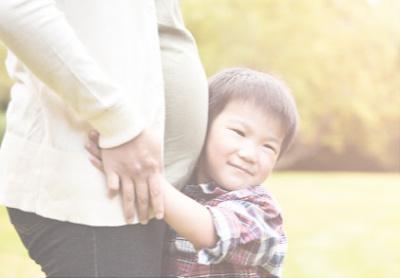The excitement for your little one only grows after that first positive pregnancy test. But the butterflies in your belly aren’t just from your enthusiasm –– those are little dances, hiccups, and stretches by your growing baby, referred to as “quickening.”
What Is Quickening?
Quickening is the feeling of your growing baby wiggling around inside your uterus for the first time.
Usually, the feeling begins as a light fluttering. Mothers-to-be often describe it as having butterflies (the kind you get with a crush!) or, another common pregnancy symptom, gas.
How you experience quickening will be as unique as your growing baby. And although most women talk about their babies kicking their bellies, your uterine walls feel your baby’s movements before your abdominal muscles.
The sensations associated with quickening will intensify as your pregnancy progresses. What began as a light fluttering may turn into a full-blown wrestling match against your ribs as you near your due date.
But don’t worry –– it’s all part of the growing process!

Why Does Quickening Happen?
You may feel like your baby is restless inside your tummy, rolling and jumping and stretching all around –– and you would be right!
Quickening is your body’s direct response to your baby’s movements. As your little one grows, they’ll try out new muscles and move around in your womb. You’ll feel anything from light fluttering to sharp, sudden jerks.
You may also notice that your little one is the most active at certain times of the day. This is no coincidence. You and your baby are physically and emotionally connected –– what you feel, your baby feels.
This means when you eat, your baby may respond to things that are particularly yummy (think sugar or caffeine). They may also become more active in response to sounds and sights that excite you or bring you joy (really anything that spikes your adrenaline).
Most often, your baby will be active at night, much to your sleep schedule’s chagrin. As you settle down for the night, your baby will kick and squirm, trying to make themselves comfortable.
Some women even wake from the quickening in the middle of the night, but this is completely normal!
This is because babies are more or less nocturnal during pregnancy. While you are running errands and walking around all day, your baby is snoozing. At night, as you settle down for some well-deserved rest, your baby is just waking up.
Simulating some of the same behaviors that put babies to sleep at night should help fend off an overly restless baby in the womb.
Take a little walk around the house. Have a snack. Talk to your baby to soothe them. Eventually, they should adjust to your schedule in the late stages of pregnancy.

When Does Quickening Begin?
Your baby will actually begin moving as early as eight weeks into your pregnancy. But you won’t feel it yet! In fact, for the first trimester, you likely won’t know when your little one is rolling around.
Most women begin noticing quickening during the middle of their pregnancy, between 13 and 16 weeks from their last missed period. First-time mothers, on the other hand, may experience the sensation of quickening a little later, between 18 and 20 weeks.
This is because new moms aren’t sure what to look for, so some early movements may fly beneath their radar. Mothers who have given birth before tend to have more relaxed uterine muscles, which makes them more perceptive to their baby’s movements.
But even so, it’s not abnormal for experienced mothers to also feel quickening a little later in their pregnancy. The huge variations in pregnant women’s experiences have to do with:
- How active your baby is (and each one is unique!)
- How active you are during your pregnancy (keep in mind that seasons can influence activity –– who is going for brisk walks during January blizzards?)
- Where your placenta lays (farther forward in the uterus means it might be a little harder to feel your baby)
Unlike most people may think, weight isn’t shown to matter. Since your uterine muscles are the first to feel your baby’s movements –– not your abdominal muscles –– your weight shouldn’t affect your ability to feel your baby move.
All of that to say: don’t panic if you don’t get those butterflies as early as 16 weeks!
All pregnancies are different, and your experiences may vary. But do check with your doctor if you feel concerned about your or your baby’s development.

How Should You Monitor Your Baby’s Kicks?
As soon as you begin noticing signs of your baby’s quickening, it’s time to start taking note of the patterns that your baby’s movements follow. Tracking their movements should start at 25 weeks and continue until near the end of the third trimester.
Is your baby super active at night or in the morning? Do they seem more responsive to music or certain sounds around the house? Do they respond when you read or sing to them?
These are all important things to pay attention to and can be helpful when you go in for check-ups with your physician.
But how exactly do you know if your little one is moving enough? To check for the frequency of your baby’s movements, keep an eye on the clock. Jot down each time you feel your baby move as the clock ticks onward.
Once you hit 10 movements, check the clock again. How much time has passed? According to The American Pregnancy Association, 10 kicks in two hours is the normal range.
As you approach the end of your pregnancy, you may notice more intense and frequent kicks from your little one. That’s completely normal! Sit back, relax, and prepare for lift-off.
What If You Don’t Feel Your Baby Moving?
Keeping close track of your baby’s movements will give you the best idea of whether or not there’s cause for concern. Any time you feel uncertain or uncomfortable, Mustela always recommends following up with your baby’s doctor.
No one knows your body or your baby better than you. If you feel that your little one’s activities are abnormal compared to how they usually behave, you should definitely reach out to a medical professional for additional guidance.
After all, quickening should be an exciting reminder of your baby’s continuous growth. You never want it to become a source of anxiety.
Keeping up with the patterns of your baby’s quickening behaviors from early on will help you identify what’s normal and when you should reach out to your doctor.

What To Remember About Quickening
Quickening is a unique and exciting experience for pregnant women, no matter if it's your first, second, or third pregnancy.
Remember, quickening can mean different feelings for different women –– even different pregnancies. These include:
- Butterflies
- Hunger pains
- Nausea
- Trapped gas
What is most important is to listen to your body and learn your baby’s quickening patterns. As the months stretch on and your baby grows larger and larger, pay attention to the things that make their movements more frequent and what those things might mean.
Is your little one hungry? Happy? Sleepy? Did you have a little too much sugar? Are you feeling anxious?
Tracking your baby’s movements —both their frequency and the time when they tend to happen — will help you keep your and your little one’s health in check as you wait for the special day!
And if you ever feel concerned about a lack of movement from your baby, don’t panic. Always be sure to double-check with your doctor. They have your and your baby’s best interests at heart (and be sure to bring those notes; this is where they come in handy!)
Expert tip: As your little one grows, so will your belly! Be sure to stock up on natural, soothing skincare essentials, like Mustela’s Maternity Collection.
With these mommy- and baby-safe products, you can address any skin concerns you might have while keeping your skin moisturized, healthy, and comfortable until the big day!
So sit back and enjoy those little moments between just you and your baby (even if their elbow is in your side!). Know that all those stretches and kicks mean they are growing into a happy, healthy little ball of joy –– one that will be in your arms before you know it!












